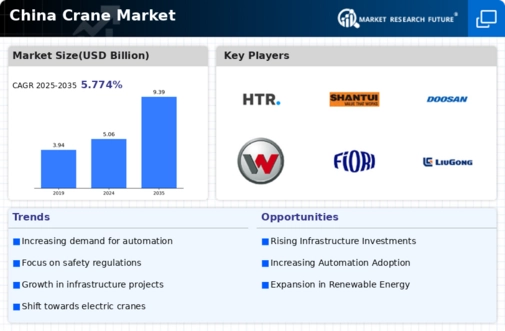Emerging Rental Market
The crane market in China is witnessing a shift towards rental services, driven by cost-effectiveness and flexibility. Many construction firms prefer renting cranes rather than purchasing them outright, as this approach reduces capital expenditure and maintenance costs. In 2025, the rental segment is expected to capture approximately 30% of the overall crane market. This trend is particularly prominent among small to medium-sized enterprises that may lack the financial resources for large-scale purchases. As a result, rental companies are expanding their fleets and diversifying their offerings to meet the growing demand, thereby stimulating the crane market.
Rising Construction Activities
The crane market in China is experiencing a surge due to increasing construction activities across various sectors. The government has initiated numerous infrastructure projects, including highways, bridges, and urban developments, which require advanced lifting equipment. In 2025, the construction sector is projected to grow by approximately 8%, driving demand for cranes. This growth is further supported by private investments in real estate and commercial buildings. As a result, the crane market is likely to see a significant uptick in sales and rentals, as construction companies seek to enhance their operational efficiency and productivity.
Increased Focus on Sustainability
The crane market in China is adapting to a growing emphasis on sustainability and eco-friendly practices. As environmental regulations become more stringent, manufacturers are developing cranes that are energy-efficient and produce lower emissions. In 2025, it is anticipated that sustainable cranes will represent about 20% of the total market share. This shift is driven by both regulatory pressures and a growing awareness among consumers regarding environmental impact. Consequently, companies that prioritize sustainability in their operations are likely to gain a competitive edge in the crane market, appealing to environmentally conscious clients.
Government Regulations and Standards
The crane market in China is influenced by stringent government regulations aimed at ensuring safety and operational efficiency. The introduction of new safety standards and compliance requirements has compelled manufacturers to innovate and upgrade their equipment. In 2025, it is estimated that compliance-related investments in the crane market will account for around 15% of total market expenditure. This regulatory environment not only enhances safety but also drives technological advancements, as companies strive to meet these standards. Consequently, the crane market is likely to benefit from increased demand for compliant and technologically advanced cranes.
Technological Integration in Operations
The integration of advanced technologies in crane operations is reshaping the crane market in China. Innovations such as telematics, automation, and remote monitoring systems are enhancing operational efficiency and safety. In 2025, it is projected that around 25% of cranes sold will incorporate smart technologies, reflecting a growing trend towards digitalization in the construction sector. This technological shift not only improves productivity but also reduces downtime and maintenance costs. As construction companies increasingly adopt these technologies, the crane market is likely to experience a transformation, with a focus on high-tech solutions.

























Leave a Comment